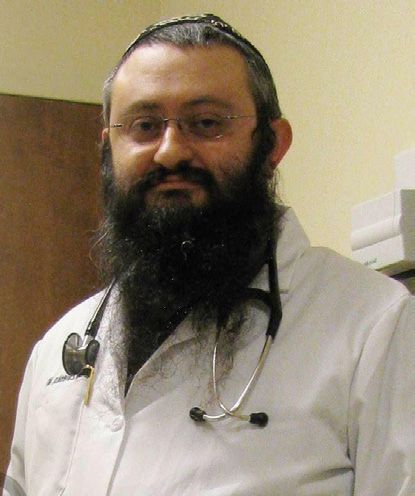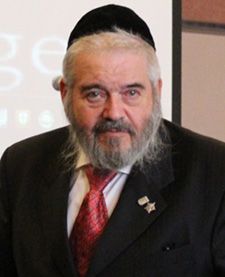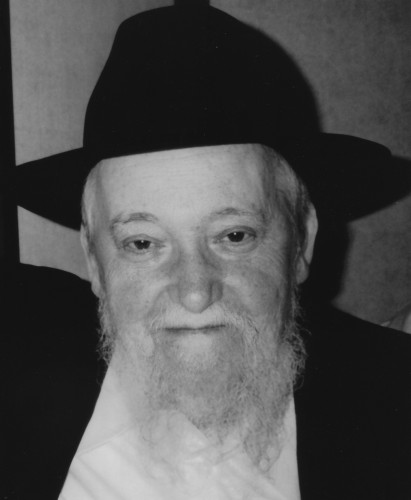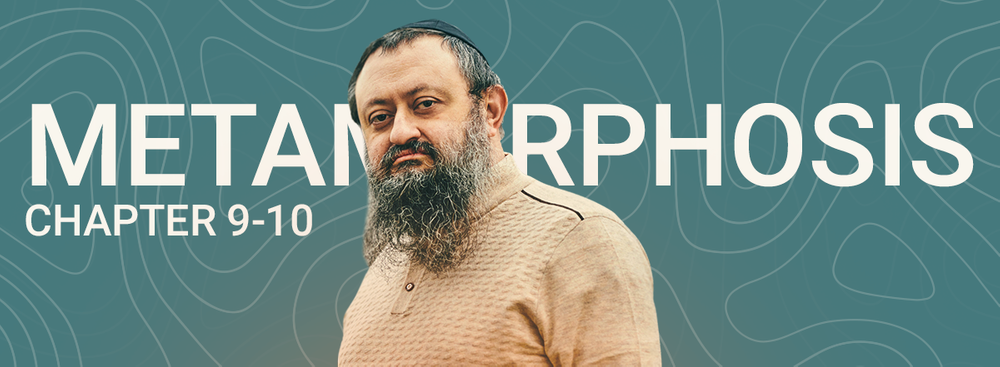In 2018, Dr. Vladimir Zelenko published an autobiographical book Metamorphosis, in which he talks about how he, being a completely non-religious young man, came to faith, and how he overcame a serious illness. The book has multiple positive reviews online and was well received by the readers all around the world.
Today, we are publishing the ninth and the tenth chapters of the book.
§9
BACK TO BUFFALO
I returned to Buffalo in the summer of 1998 to start my third year of medical school. Leaving the seclusion of the yeshivah environment was challenging. I had gotten accustomed to focusing exclusively on my spiritual development. Now it was time to return from heaven and deal with the mundane world. During my year abroad, I had even entertained the idea of leaving medical school and becoming a rabbi. Rabbi Gafne explained to me that I could serve G-d through being a doctor and strongly encouraged me to finish my medical studies.
One thing that made my life in Buffalo easier was that a new Jewish high school had just opened. The school used a house as a dormitory and I moved into this house. I helped the dorm counselors with the boys and occasionally gave lectures on Jewish mysticism. In return, I had catered kosher food, Jewish books, and a minyan right there in my home environment.
On one occasion, the boys from the school earned, by learning well, a weekend ski trip. Due to a last-minute schedule issue, I could not come. On the way back from the trip, the van that the boys were in lost control and flipped over. Several of the boys were ejected from the van. The driver of the van was the son of the principal of the school. The principal came to me and asked me to drive him to the accident scene. On the way there, the principal told me that earlier today he suddenly had a strong urge to call this son. He called him right as the accident had happened. His son, the driver, was upside down and in shock. His father told him to turn off the engine and instructed him on what to do next to help the boys. Amazingly, no one was seriously hurt and they all came home from the hospital after being examined. There is a Jewish mystical teaching that states that a child is derived from his father’s brain. Even after birth, this child maintains an intimate and spiritual connection with his father’s thoughts. This story— as well as the previous story regarding the man in the coma who awoke when his son put on tefillin—illustrates this point clearly.
The third year of medical school was very different from my first two years. It was divided into six clinical rotations each lasting two months. The rotations included internal medicine, pediatrics, psychiatry, general surgery, family medicine, etc. Most of my time was spent in clinical interactions with patients in the office and hospital settings. I was still not sure of what area of medicine I wanted to go into. However, I really enjoyed interacting with patients.
It was interesting to me how much my perception of other human beings had changed since I had started my spiritual journey. I no longer viewed other people as animalistic adversaries. Rather, I started to believe and perceive that human beings have a Divine spark within them.
After completing my third year, I decided on family medicine. This specialty really fit my temperament. I found family medicine to be a unique specialty in that you are required to be proficient in all areas of medicine. A family doctor must treat everything from newborns to geriatric patients and everything in between. More importantly, to be a good family practitioner you need to build trust and form relationships with your patients.
The fourth and final year of medical school was filled with clinical exposure to other specialties in medicine such as neurology, dermatology, rheumatology, and various surgical subspecialties. One experience that vividly stands out in my memory from this year was my rotation at Roswell Park Cancer Institute in Buffalo. I was exposed to various oncological specialties. These patients all had cancer and were very sick.
What bothered me most about this experience was that every time I would enter this cancer hospital, I saw a huge sign in the lobby that stated, “THINK ROSWELL.” The implication was that these sick patients should place their hope and faith in the abilities of finite human beings and institutions such as Roswell Park. In my opinion, this is an example of modern-day idol worship. The Jewish approach is to put all your hopes and faith into the hands of G-d. We believe that G-d gives a doctor permission to be a partner with Him in the healing process. We pray that G-d should work through the hands of the doctor. The doctor is merely a conduit for G-d’s blessing. I think the sign should have said, “THINK G-D.”
During the fourth year, most medical students applied for their residency programs. I decided to defer starting my residency in family medicine for one year to accomplish some of my other goals.
§10
CROWN HEIGHTS
In June of 2000, I received my M.D. degree and became Dr. Vladimir (Zev) Zelenko. It was a significant milestone in my life, which represented many years of intense effort. The following month I moved to Crown Heights to start learning at Yeshivah Hadar HaTorah.
My goals for this year in Crown Heights were to further solidify my skills in Jewish learning, to become a mohel[1] to find a residency program and—most importantly—to get married. I felt that I should get married prior to starting residency.
I knew that I would not have much time to search for a wife once I started working eighty hours a week.Religious dating was very different from my secular experi- ences. For religious Jews, dating is focused and goal-oriented: to find a compatible spouse to marry, with whom to build Jewish home.
mohel:trained performer of the covenant of circumcision (brit milah). ↩︎

Much of the information about each other is screened prior to meeting face to face. Usually the parents of the boy and girl do extensive research about each other’s families. Most of the religious, financial, and social compatibility issues are known in advance of the potential couple’s first meeting. In most cases, a shadchan[1] is consulted for suggestions of potential matches. My situation was different: my parents were not so familiar with the religious dating process. As a result, I had to do my own research and screening of potential candidates. I was not sure what I wanted or needed in a spouse. I knew that I did not want to be alone and that I wanted to have many children. I met many “interesting” types of people during the dating process.
On one occasion, I came to meet a young woman of Russian background at her home in Queens. I was greeted by her mother and grandmother and was thoroughly interrogated by them. I thought that they should work for the FBI. After passing their interview, I was permitted to proceed with the date. I decided to take her to a kosher restaurant for dinner. When I got to the restaurant, I had to make a U-turn to park my car. The girl informed me that I had just made an illegal U-turn. While making my order I asked the waiter for a soda. The girl advised me against products from this company since they did not support Israel. I realized that this girl was not for me but decided to have some fun.During our conversation, I asked her how she feels about my daily drinking, smoking, and staying out late. It was a short date. The next day, her rabbi called the matchmaker, wanting to know if I was an alcoholic.
On another occasion, a girl from Toronto, Canada was suggested to me. When I arrived at her house, her Georgian (not Atlanta) parents, grandparents, aunts, and uncles greeted me. After the father asked me his questions, he called out in a strong ethnic Georgian voice “Zelda, come here.” Zelda came and gave me a shy smile. Then the father said, “Zelda, you can go.” He then looked at me and said, “If you are interested, have your parents call me.” I continued my search for a wife.
I had some disappointing and painful experiences while dating. One time a girl from Cincinnati, Ohio was suggested to me. I drove there and met her several times. She was very pleasant, and we had a lot in common. During our third meeting, she told me that her family suffered from a rare genetic illness that caused severe mental problems. I was shocked, disappointed, and angry. If the matchmaker had told me this in advance, I would never have agreed to meet her. But now I had met her and liked her. I was not sure what to do next.
After coming home, I consulted with three close friends. They all told me not to proceed further. I also consulted with a religious geneticist and he told me to stay away. I called this young woman and told her that my mind was telling me one thing and my heart was telling me something else. I needed to follow my mind. She was very upset.
shadchan: professional matchmaker for Jewish marriages. ↩︎
The next day she called me and asked me to reconsider. I told her that I could not. I know she was very hurt and disappointed, and so was I. Many years later, I ran into her at a Purim event in Brooklyn. She was married and had several children, thank G-d. I was truly happy for her and asked for forgiveness for any pain that I must have caused her.
I continued to focus on my other goals even while searching for my future wife. As my learning progressed, especially in Chassidic mystical teachings, I developed a passion for teaching and spreading these ideas. I would give a weekly class to Russian Jews in a shul[1] in Brighton Beach, Brooklyn. I had around a dozen students of various ages. A few years later, I was asked to be a guest speaker at Hadar HaTorah yeshivah. After my talk, a student from the yeshivah approached me. He was dressed like and looked like a mainstream Chassidic student. He said to me, “Zev, do you remember me?” I did not recognize him. He reminded me that when he was thirteen years old, he and his father would attend my weekly class. He told me that I had taught him how to read Hebrew and explained to him the fundamental principles of Judaism. I had been privileged to plant a seed that blossomed into something beautiful.
shul: Yiddish term for a Jewish house of worship. ↩︎

I also started to learn how to be a mohel, from Rabbi Rami Cohen from Boro Park, Brooklyn. Amazingly, it turned out that he had been my mohel twenty-three years earlier. I wanted to learn how to circumcise my own sons for when the time would come. I traveled around New York with Rabbi Cohen for six months, watching and learning from him how to become a mohel. One day, a friend of mine from Buffalo called and asked me to help arrange his bris. He was a Russian Jewish archeologist who I had met at Rabbi Greenberg’s shul. We became close friends and when he later reached the point that he wanted the bris he had not received as an infant in Soviet Russia, he remembered that I had mentioned to him earlier that I wanted to become a mohel.
Rabbi Cohen and I flew to Buffalo and we were met by Rabbi Greenberg at the airport. We all drove to Akron, New York, a very small town twenty-five miles from Buffalo. We arrived at my friend’s home, which was an old farmhouse from the 1900s in the middle of nowhere.

Rabbi Greenberg was sandek[1] and Rabbi Cohen and I performed the bris on his kitchen table. Afterward, he chose a name and we had a festive meal all together. Rabbi Cohen told me that he had performed over thirty thousand brisim during his career, but this was by far the most unusual and special.
On another occasion, Rabbi Cohen was asked to perform a bris on an adult at a local community hospital in Brooklyn. He had special privileges that allowed him access to the operating room. I went with him to the operating room and met the Russian Jew who would be circumcised. He was a man in his fifties and was accompanied by Rabbi Zalman Shagalov. We performed the bris and he chose his new Jewish name. Afterward, I had a long talk with Rabbi Shagalov and learned that he was the rabbi of the synagogue called F.R.E.E. in Crown Heights. That was the place to which my father had taken me to arrange for my bris when we had first come to America. Rabbi Shagalov invited me to come to his shul on Shabbos and then for a meal at his house.
Rabbi Shagalov was born in Russia during the worst days of Stalin’s murderous rule. His father was a mohel who performed circumcisions, against the laws of the government. Rabbi Shagalov’s father disappeared one day and he was never seen again. In the 1990s when the Soviet Union fell apart, certain classified documents were found. It was discovered that his father had been executed by an NKVD firing squad for counterrevolutionary activities.
sandek: During the bris (brit milah) ceremony, the sandek is the person who holds the Jewish baby boy—or, in this case, adult—during the procedure. ↩︎
I became close friends with Rabbi Shagalov and would frequently attend his shul on Shabbos. I felt at home with the Russian Chassidim and enjoyed the vodka, potatoes, and herring that were served after davening[1] Rabbi Shagalov would also frequently ask me to speak words of Torah in his shul after Shacharis[2]
Rabbi Shneur Zalman HaLevi Shagalov, o.b.m. During my year in Crown Heights, I also started to apply and interview for residency programs in family medicine. I needed a program that would accommodate Shabbos and Yom Tov observance. In return, I was willing to work all Sundays and secular holidays.

During my year in Crown Heights, I also started to apply and interview for residency programs in family medicine. I needed a program that would accommodate Shabbos and Yom Tov observance. In return, I was willing to work all Sundays and secular holidays.
The first program I interviewed in was at Jamaica Hospital in Queens, New York. The interview was by a panel of six physicians. Several of these physicians were African American women. As is customary, everyone wanted to shake my hand. I explained that I do not shake hands with women. The female physicians on the panel were offended. During the interview, I was asked how I would handle issues that contradicted my religious beliefs. I answered that my belief system is of prime importance in my life and that my professional career had to conform to my religious principles. I got everyone’s attention by bringing up the example of shaking hands with women.
I simply explained that professionally I had no problem with providing comprehensive medical care to the female gender. However, in a social context, I adhered to boundaries that reflected my values. I explained that one way that Judaism respects and honors women is by reserving touch for the proper context. One of the women said, somewhat jokingly, that she wants to become Jewish. I was offered a residency position with accommodations for Shabbos and Yom Tov.
This experience taught me that people respect someone who adheres to his values and is not willing to bend those values for professional reasons. For personal reasons, I declined the position and continued my search.
I eventually interviewed at the “South Nassau Communities Hospital” family residency program in Oceanside, New York. The program director was Dr. Sam Sandowski, an observant Jew. I was offered a residency position with accommodations for Shabbos and Yom Tov. I felt that this program was a very good match for me and accepted the position. Dr. Sandowski was instrumental in arranging the religious accommodations and became my professional mentor. I became friends with Sam. One time, over dinner, he told me a story of how the Lubavitcher Rebbe, Rabbi Menachem Mendel Schneerson, had given one of Sam’s children a blessing for a full recovery from a serious medical issue, and the child recovered. Just recently, this child had gotten married and Dr. Sandowski went to pray at the gravesite (Ohel) of the Rebbe on the day of the wedding.
Toward the end of my year in Crown Heights, I was introduced to Sima Chana Shollar. She was nineteen and I was twenty-seven years old. During our first date, we had a pleasant time and it seemed that we had similar goals. We both discussed having a large family built on the Torah and Chassidic values. We went out three times in four days (I took a day off to not go too fast) and decided to become engaged. When I met her grandmother for the first time, she asked me if I was a rabbi. I answered that I was a doctor. She misheard and asked me where my shul was. Therefore, I repeated that I was a doctor, so she said “Ohhhhh, A DOCTOR.” Two months later, we were married in Crown Heights.













